Daging Masak Kicap is a traditional Malay beef stew with a rich, savory flavor. I used to cook it for my customers while running the restaurant. Since leaving the industry and focusing on developing my food blog, I haven’t prepared it in quite a while. However, the taste has always lingered in my mind. Today, after picking up some beef from the supermarket, the idea of making Daging Masak Kicap suddenly returned to me.
Making Daging Masak Kicap requires various spices traditionally used in Malay cuisine. Daging Masak Kicap can be loosely translated as “soy sauce beef.” Another common name is Daging Hitam Manis, which hitam means “black” in Malay—and once you see the finished dish, you’ll understand why. The beef turns to a very dark color after cooking, almost black in appearance.
I encourage you to try this recipe because it’s incredibly straightforward to make and because the flavor is truly unique. The flavor is unlike any Western beef stew and distinct from any Cantonese-style stews I’ve tried or made. If you’re searching for a recipe that offers something new and exciting to your palate, this is the one.
Note: This post may contain affiliate links. Please read my privacy policy for more info. I may receive commissions for purchases made through links in this post. As an Amazon Associate, I earn from qualifying purchases.
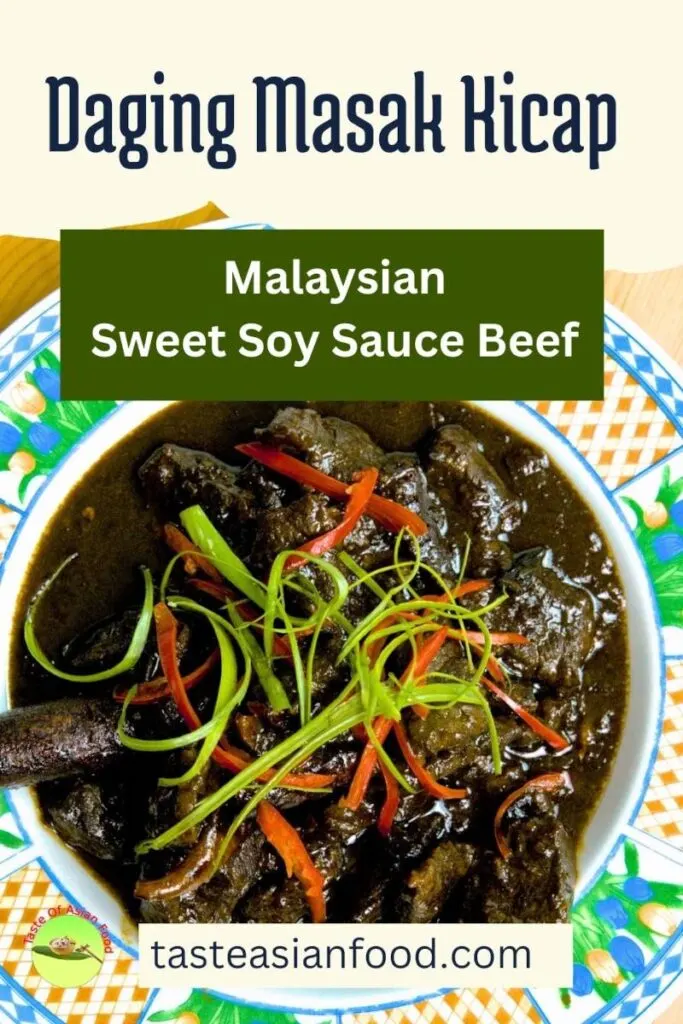
The main ingredients required to make Daging Masak Kicap
- Beef. The best cut of beef for this dish is sirloin, which ensures you get tender beef, but it can be pretty expensive. So you can use any cut of beef that is suitable for stewing. That’s precisely what I used today: rump steak, which is more affordable.
- Sweet soy sauce. Aside from the beef, the most crucial ingredient in this dish is sweet soy sauce. Known in Malay as Kicap Manis, I’ve always used the Habhal or ABC brand. This sweet soy sauce is very different from Chinese light soy sauce or Japanese soy sauce. It’s thick, dark, and has sweet flavors—almost syrupy, like melted sugar. Please don’t substitute it with Chinese or Japanese soy sauces; it will change the dish’s flavor completely.
- Spices. This recipe also calls for several local spices. The essential ones include fennel seeds, cumin seeds, tamarind paste, green cardamom pods, cinnamon sticks, dried chilies, and star anise. While other versions may use different spice blends, this is a time-tested combination I’ve relied on for years.
How to prepare Daging Masak Kicap
1. First, slice the beef against the grain into pieces about 1/2 centimeter (1/4 inch) thick. Avoid cutting the beef too thin, as it may break apart during cooking. Alternatively, you can cut it into small cubes. Next, marinate the beef with sweet soy sauce, sugar, and white pepper powder for at least one hour..
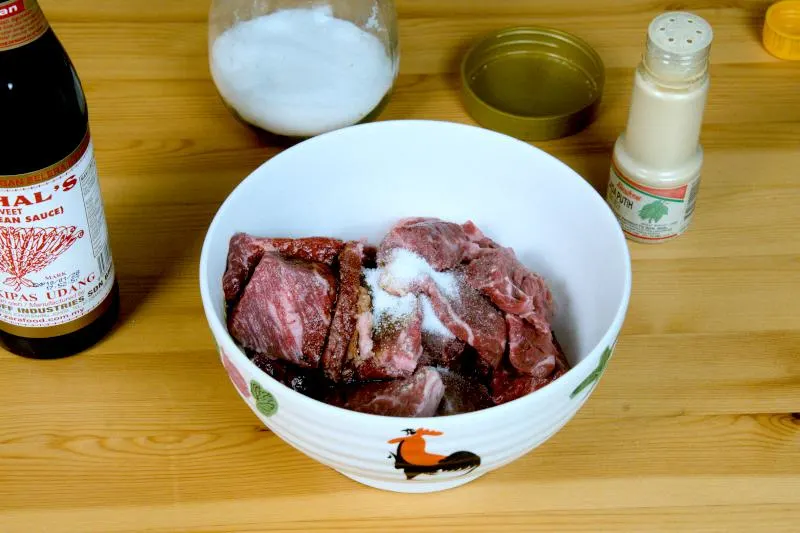
2. I recommend using whole spices for this recipe. I grind the fennel and cumin seeds, but you can substitute them with store-bought ground spices if that’s too troublesome or unavailable.
Soak the tamarind pulp in warm water until soft to release its flavor. Strain the tamarind juice through a fine-mesh sieve to extract the tangy tamarind juice, discarding the seeds and pulp. Fresh tamarind pulp is easy to find in Malaysia, but you can substitute it with store-bought tamarind paste if unavailable.
Heat the vegetable oil in a pan and sauté the onion and garlic.
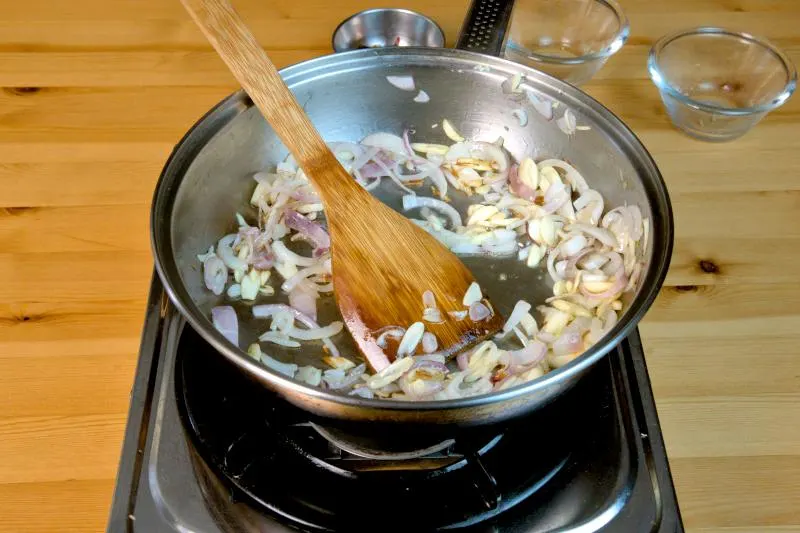
3. When the onion turns soft and translucent, mix the marinated beef with the onions. At the same time, incorporate all the remaining ingredients listed in the recipe.
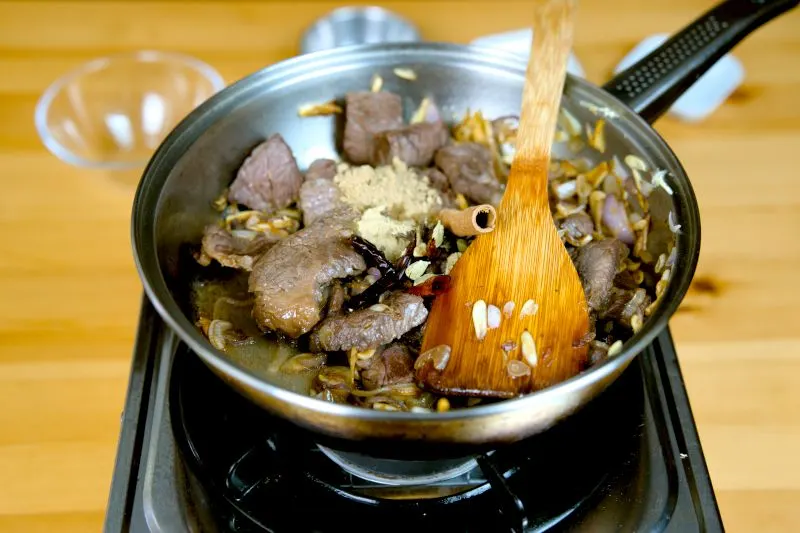
4. Pour in just enough water to barely cover the beef, then increase the heat to bring it to a boil. Once boiling, reduce the heat to the lowest setting and simmer for about two hours or until the beef is tender. Check the water level occasionally to prevent it from drying out. Add more water if needed.
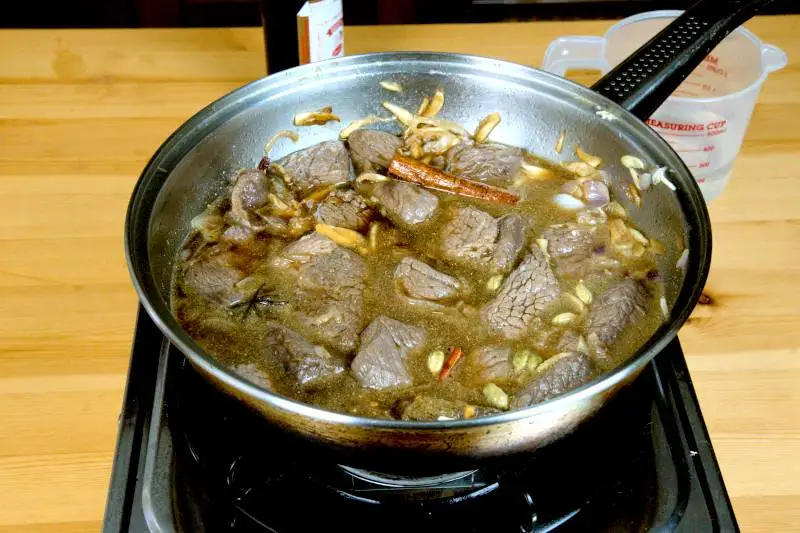
5. After two hours, check the beef to see whether it is already tender. Then, continue simmering to reduce the liquid until it thickens into a rich and flavorful sauce.
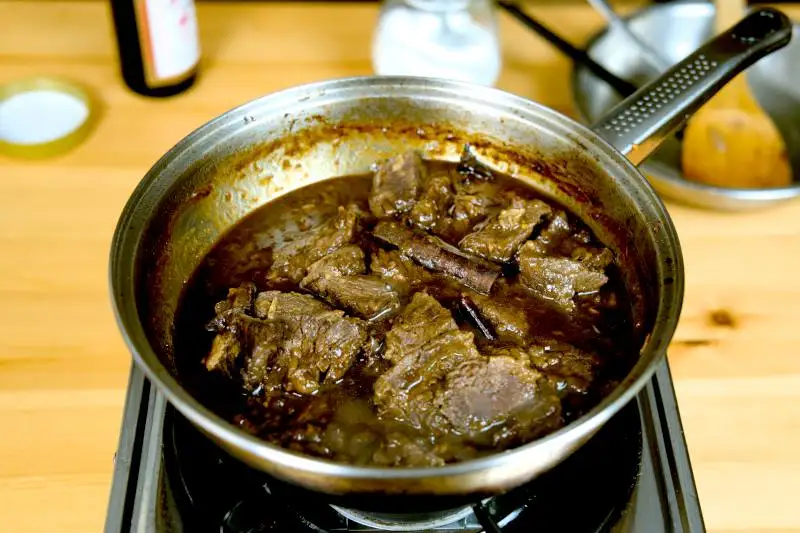
6. Transfer the beef to a serving plate. It pairs best with something light like white rice, because of its bold, savory flavor. You can also serve it with Biryani rice or flatbread, like naan.
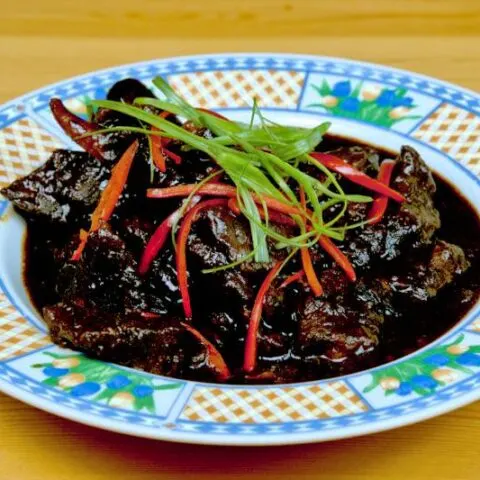
Daging Masak Kicap Recipe
A guide to making authentic Daging Masak Hitam, a Malaysian beef dish with sweet soy and warm spices. Great for meal prep and packed with flavor.
Ingredients
Ingredients A (marinate beef)
- 450g beef
- 1/4 tsp ground white pepper
Ingredients B
- 3 tbsp sweet soy sauce
- 3 dried red chilli
- 2 tsp sugar
- 3/4 water
- 1 tsp fennel seeds
- 1 tsp cumin seeds
- 1 tsp tamarind pulp
- 8 green cardamom pods
- 1 cinnamon stick
- 1 star anise
- 2 tbsp vegetable oi
- 8 cloves garlic
- 1 small size onion
Instructions
- Slice the beef against the grain into pieces about 1/2 centimeter (1/4 inch) thick.
- Next, marinate the beef with sweet soy sauce, sugar, and white pepper powder for at least one hour.
- Soak the tamarind pulp in warm water until soft to release its flavor. Strain the mixture through a fine-mesh sieve to extract the tangy tamarind juice, discarding the seeds and pulp.
- Heat the vegetable oil in a pan and sauté the onion and garlic.
- When the onion turns soft and translucent, mix the marinated beef with the onions. At the same time, incorporate all the remaining ingredients into the recipe.
- Pour in just enough water to barely cover the beef, then increase the heat to bring it to a boil. Once boiling, reduce the heat to the lowest setting and simmer for about two hours or until the beef is tender. Check the water level occasionally to prevent it from drying out. Add more water if needed.
- After two hours, check the beef to see whether it is already tender. Then, continue simmering to reduce the liquid until it thickens into a rich and flavorful sauce.
- Transfer the beef to a serving plate.
Recommended Products
As an Amazon Associate and member of other affiliate programs, I earn from qualifying purchases.
-
Soeos Szechuan Dried Chili,Dry Szechuan Pepper, Dry Chile Peppers, Sichuan Pepper, Dried Red Chilies, 4oz, (Very Mild Spicy)
-
 TBWHL Skimmer Slotted Spoon, Heavy Duty 304 Stainless Steel Slotted Spoon with Vacuum Ergonomic Handle, Comfortable Grip Design Strainer Ladle for Kitchen, 14.96 Inches
TBWHL Skimmer Slotted Spoon, Heavy Duty 304 Stainless Steel Slotted Spoon with Vacuum Ergonomic Handle, Comfortable Grip Design Strainer Ladle for Kitchen, 14.96 Inches -
 Tamicon Tamarind Paste
Tamicon Tamarind Paste
Nutrition Information:
Yield: 2 Serving Size: 1Amount Per Serving: Calories: 1686Total Fat: 103gSaturated Fat: 34gTrans Fat: 1gUnsaturated Fat: 51gCholesterol: 347mgSodium: 4562mgCarbohydrates: 75gFiber: 5gSugar: 35gProtein: 116g
This data was provided and calculated by Nutritionix on 4/4/2025
How to store the leftovers of Daging Masak Kicap
Since Daging Masak Kicap freezes well, you can prepare a larger batch and keep the extra. Transfer the beef to a freezer-safe container to store it in the freezer. It can be kept for several weeks without losing much flavor. If you only plan to store it for a day or two, simply place it in an airtight container and refrigerate it.
How to reheat the beef?
To serve leftover Daging Masak Kicap, thaw it at room temperature if it is frozen. Then, transfer it to a small pot, add a few tablespoons of water, and reheat over medium heat until it comes to a boil. Continue simmering until the sauce thickens to your desired consistency, then serve.
Can I cook it in the pressure cooker to simplify the cooking process?
You can certainly use a pressure cooker to reduce the time required to stew the beef. Pressure cook it for 35 minutes and allow the pressure to release naturally. After the pressure has been released, there will still be a significant amount of liquid in the pot. In this case, you can remove all the beef with a slotted spoon and set the cooker to sauce thickening mode to thicken the liquid. Finally, mix the beef with the thickened sauce before serving.

Trish
Monday 21st of April 2025
How much onion and garlic? I've scoured the recipe several time and can't find quantities for either of them!! Planning on making this tomorrow (Monday), so would appreciate a quick answer please x
Trish
Sunday 4th of May 2025
@KP Kwan, Thanks, my friend.
KP Kwan
Tuesday 22nd of April 2025
I am sorry I left these items out from the ingredient list. The amount is 8 cloves garlic and one small size onion. I have corrected the recipe. Thanks.
Chris
Sunday 6th of April 2025
Hi, How much water to soak the tamarind pulp and do I just add the juice to the recipie please?
KP Kwan
Monday 7th of April 2025
The amount of water used to soak the pulp does not matter as it will be part of the stewing liquid. Normally, I add 3-4 tbsp of hot water to soak it, then remove the seeds, and then add it to the stew.
KP
Sunday 6th of April 2025
Hi, this is KP Kwan. I’m delighted to see you here in the comment section after reading my recipe. I’ll be happy to answer any questions or comments as soon as possible.
Trish
Monday 7th of April 2025
@KP, Recipe says soak the tamarind pulp - if I have tamarind paste, how much of it and if I soak that, how much water do I soak it in? Thank you.